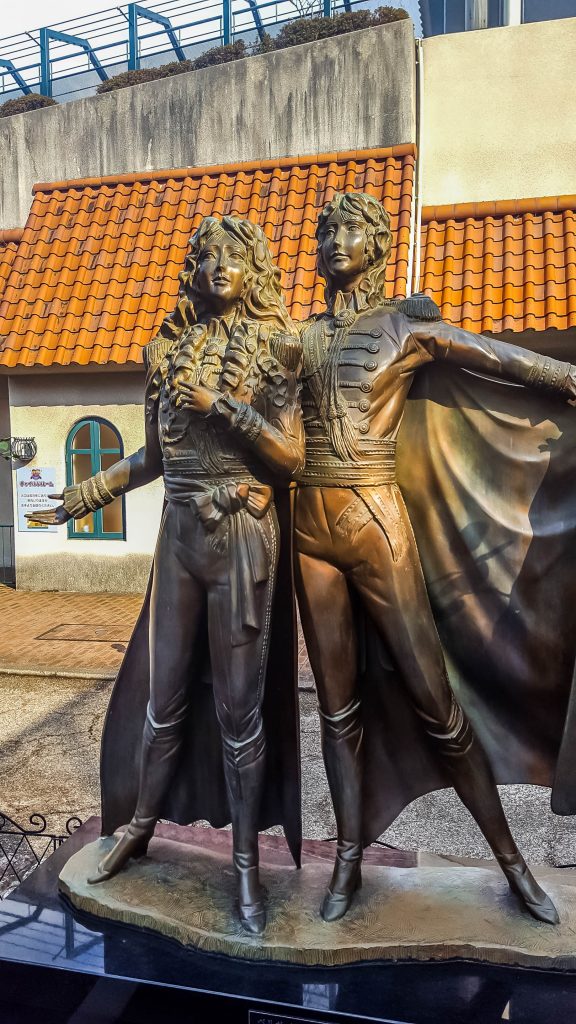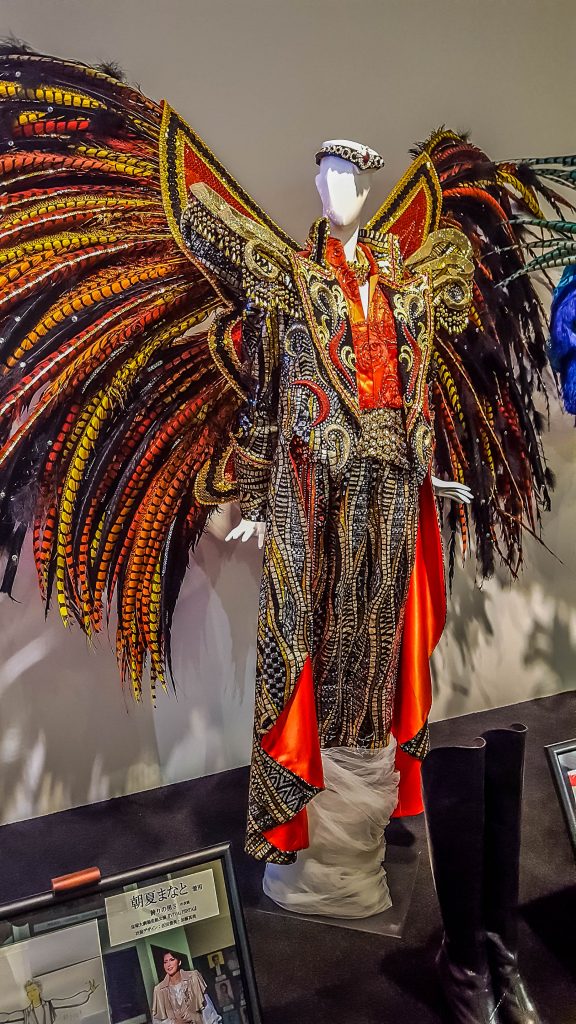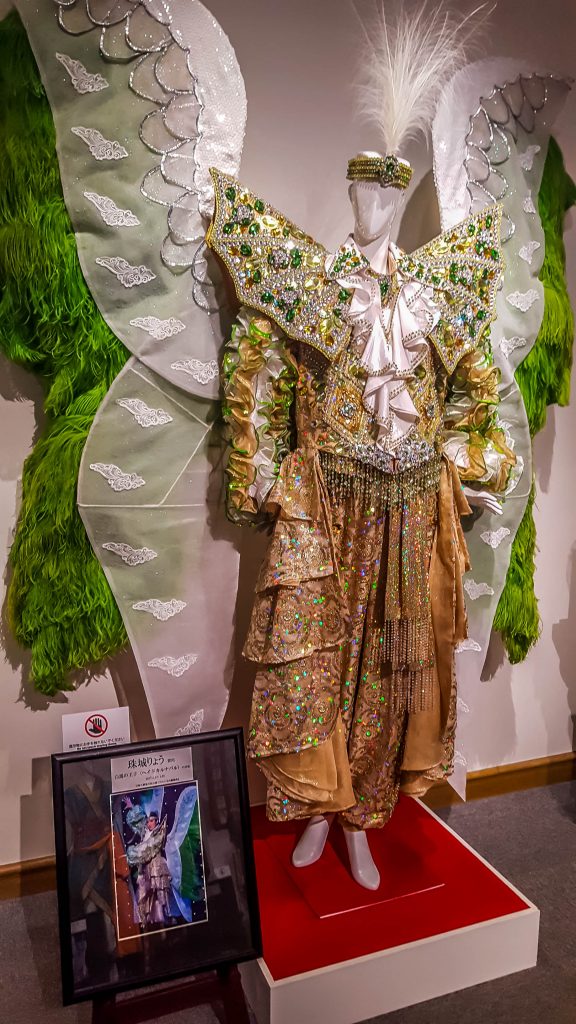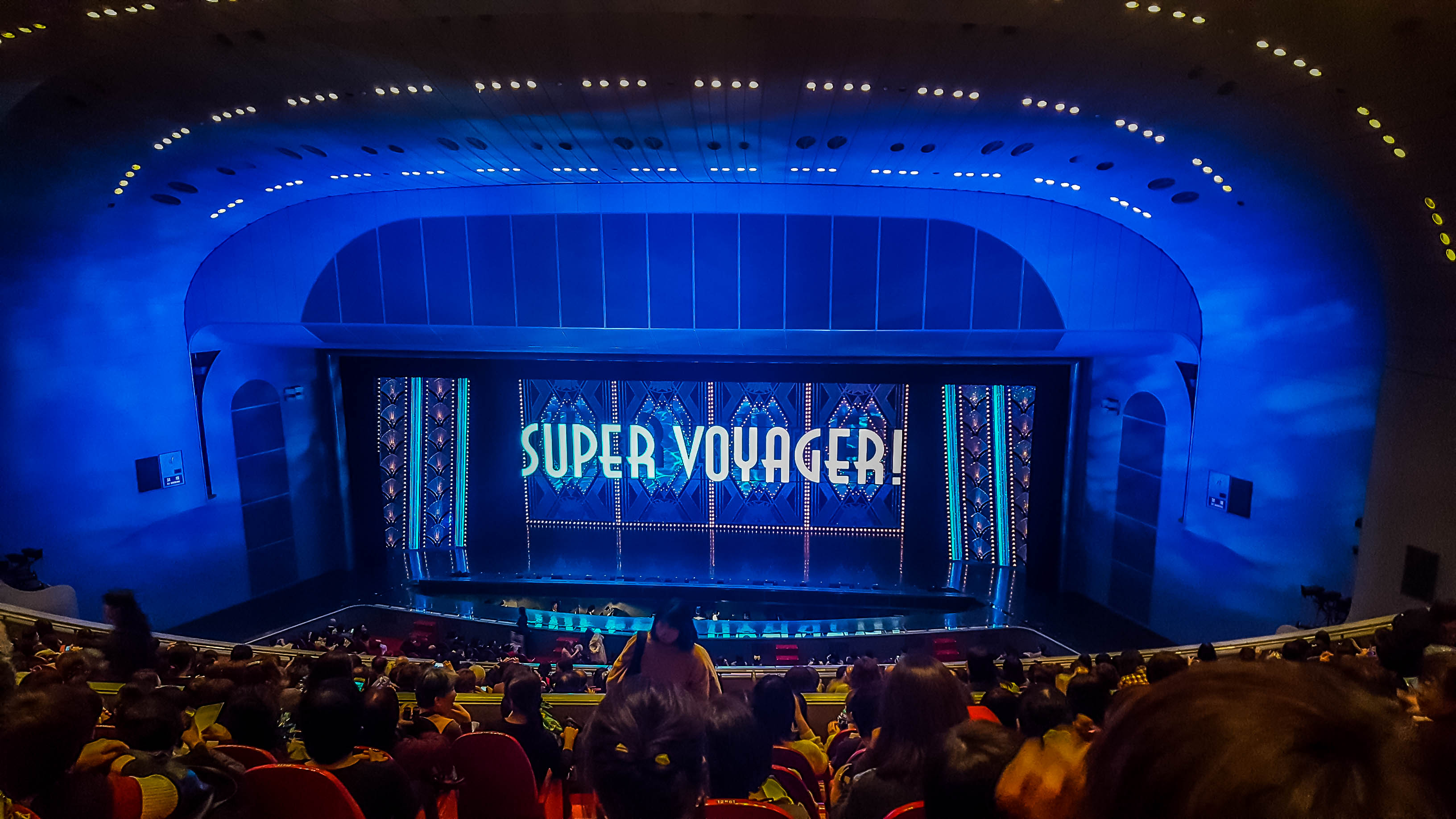This article originally featured in the November 2019 issue of Connect.
Laura Steblay (Osaka)
Introduction
If you’ve ever found yourself riding the Hankyu train line that stretches from Umeda in Osaka to Takarazuka in Hyogo, chances are you’ve noticed the posters with dramatic titles and beautiful, heavily made-up figures wearing striking costumes. These posters are the outward face of the Takarazuka Revue, an all-female Japanese theater company which produces lavish, Western-style musicals in central theaters in Tokyo and Takarazuka City. This concise description tends to raise more questions than answers, however, and trying to learn more about this unique form of theater can be daunting. When I first discovered the Takarazuka Revue over five years ago through the internet, I was simultaneously fascinated and baffled by the productions, culture, and theatrical conventions of the Revue. Let’s unpack some common questions about this intriguing art form.

Wait… They’re all Women?
All-female performances, let alone a whole company comprised only of women actors, are not common in the theater world. While the concept of cross-dressing theatrically has a long history, from the elegant onnagata of kabuki, to the boy actors of the Shakespearean stage, to the TV star drag queens of today, these familiar examples almost always consist of men performing as women. The reverse is much less common, making Takarazuka a unique and fascinating example of cross-dressing women. Although the company makes no effort to hide this fact, some people who encounter the Revue for the first time are incredulous that these anime-looking dreamboats are not “real” guys.
The shows that Takarazuka produces always have male characters, so how do they achieve this visible gender binary in their all-female company? The actresses, known as Takarasiennes, are split up into the two genders of Takarazuka: otokoyaku (or “male role”), who play the men, and musumeyaku (or “daughter role”), who play the women. The actresses perform their “assigned” genders in intentional and stylistic ways, often pulling inspiration from classic Old Hollywood stereotypes, as well as aspects of Japanese pop culture such as anime and manga. The otokoyaku aren’t trying to mimic real-life, everyday men, but rather represent a kind of idealized man who is dashing, heroic, and romantic. The musumeyaku work to contrast and balance this image with their femininity, making the otokoyaku seem masculine in comparison. These gendered divisions and dynamics also carry into the offstage lives of the performers, where the otokoyaku sport short hair, wear pants, and speak in more masculine voices, while the shorter, often younger musumeyaku dress in a feminine style and tend to exhibit gentler mannerisms. These carefully constructed gender expressions make the Takarasiennes stand out offstage as well as on.
What’s it Like to See a Show?
Many foreign fans, myself included, liken the experience of attending a show at a Takarazuka theater to that of visiting Disney World. The company often bills Takarazuka as a fantastical world of dreams, and the very specific atmosphere and aesthetic can feel like a different universe. Both the Grand Theater in Takarazuka and the Tokyo Takarazuka Theater are enormous, seating over two thousand people each, and the technical capabilities of the sets and stage rival the biggest shows on Broadway. Each of the main performances in these theaters consists of either a one-act musical followed by an extravagant song and dance revue, or a two-act musical with a mini revue before the curtain call. Some of these musicals are imports from Broadway or Europe, while others are Takarazuka originals drawn from a wide variety of sources (and by wide, I mean from sources as diverse as Japanese historical figures, Shakespeare plays, foreign movies like Ocean’s 11, and anime like Rurouni Kenshin).
Although the musicals are always a fascinating experience, the revues are hands-down the most iconic and unique aspect of Takarazuka. These visually dazzling shows, which often follow a vague theme and have little continuous plot, showcase the skills and allure of the performers in stunning scenes filled with dancing, singing, live music performed by the orchestra, special stage effects, and sparkles. So many sparkles! The costumes, while sometimes historically questionable, are always glamorous. The heavy makeup and fake eyelashes may seem over the top to some, but just like the intricate makeup of kabuki, it helps define unique traits of a character while enabling the giant audience to read facial expressions. Even if you don’t understand any Japanese, the visuals of the shows alone make for an unforgettable experience.
How Did the Revue Begin?
What’s one to do when it’s 1914, you’re a railroad tycoon, and no one wants to ride your train line to the small hot-spring resort town of Takarazuka? After some failed attempts involving unheated indoor swimming pools, Hankyu Railways founder Kobayashi Ichizo finally found the winning ticket: start an all-girls theatre company! People found the performances much more enticing than swimming in chilly water, and Kobayashi soon founded the Takarazuka Girls Opera School, appealing to the daughters of well-to-do families from as far away as Kagoshima as a suitable way to spend their teenage years between childhood and marriage.
Reflecting the experimentation and blending of cultures of the Taisho era, the shows Kobayashi produced combined the “dance, song, and skill” of kabuki with the spectacle of Western-style theater. The 1920s brought to the company the introduction of the French-inspired revues, the addition of performances in Tokyo, and the construction of the Grand Theater, the largest modern-style theater in Japan at the time.
In the 1970s the Revue truly took on the form that we see today, with the production of a musical version of Rose of Versailles (Berusaiyu no Bara), a manga by Riyoko Ikeda about Marie Antoinette and a cross-dressing female guard named Oscar. This show and the actresses starring in it became so wildly popular that it was known as the “BeruBara Boom,” and this phenomenon gave Takarasiennes the star status that still continues today.

Why Do the Same Actresses Keep Playing All the Main Roles?
As a theater kid, the idea of a handful of actors in a troupe always getting the best roles would have seemed like favoritism, but that’s exactly how Takarazuka is designed to work. Unlike Broadway and many regional theaters, individual roles in Takarazuka shows aren’t cast by auditioning large numbers of people to find the perfect fit for that role. Rather, all of the Takarasiennes in a troupe are assigned to roles based on a (sometimes complex and mysterious) hierarchy. The roughly 400 performers are divided into five main troupes (Flower, Moon, Star, Snow, and Cosmos) which perform shows in rotation at the two main theaters. There’s also a special troupe for older actresses, as well as national (and sometimes international) tours.
All Takarasiennes start their career in the Takarazuka Music School (TMS), which auditions over a thousand girls between the ages of 15-18 every year. About 40 are accepted to the strict two-year program, where they are trained in singing, acting, and both Japanese and Western styles of dance. The senpai/kouhai culture of Japanese schools and workplaces is strictly observed in TMS, and this dynamic of deferring to seniors carries throughout their time in Takarazuka.
After their debut into the company as full-fledged Takarasiennes, the actresses are assigned to one of the troupes. As young actresses, they will first be given only very small roles, but they have the potential to move up in the hierarchy. Each troupe is headed by a Top Star, a popular and experienced otokoyaku who essentially becomes the face and leader of her troupe, and receives all the leading roles in the main theater shows. She is partnered with a Top Musumeyaku (who usually plays her romantic opposite), and supported by a nibante (a second-in-command otokoyaku who usually goes on to become the next Top Star). As Top Stars tend to retire after 2-5 years, and actresses are constantly retiring and being introduced—the hierarchy is in an almost constant state of flux. Aspiring otokoyaku are placed on the Star Track where they are constantly tested by the company in various roles to see if they have potential (and popularity).
What’s the Deal With These Fan Clubs?
When visiting one of the theaters to see a performance, it’s hard to miss the crowds of women standing or kneeling in rows outside the stage doors. In a system more reminiscent of well-organized sports fans than theater lovers (it’s actually more similar to the traditional structure of kabuki fans), Takarazuka fans often align themselves with one particular Takarasienne to support her career. They do this by joining her fan club, through which they can buy tickets to the shows she is in and attend ochakai (tea parties) where she can interact with her fans in a slightly more private and casual environment. Supporting the actress in this way gives a concrete measure of her popularity, which can help her progress along the hierarchy of performers.
The fan club activity that is probably most mystifying to the uninformed is the practice of fans lining up by the stage doors to see the actresses enter or exit the theater for the day. Fans wait in a specific area with other members of the club to chat with and hand letters to their actress, and will sometimes wear matching themed accessories. Being part of a fan club enables fans to participate in the community of the Takarazuka Revue beyond just being spectators at a show, and gives them a personal connection and investment.
So… Are They Lesbians?

As a queer theatre artist, I’ve always been drawn to theater’s potential for allowing us to imagine ourselves in roles outside of what is considered the norm for society.Because of the fantastical romances and flirtatious revues performed by the actresses of Takarazuka, foreigners sometimes assume the Revue is “lesbian theater.” Given that the overwhelming majority of hardcore Takarazuka fans are women, many academics have written articles attempting to dissect the gender and sexual dynamics of the Revue, attributing fans’ passion variously to homoromantic desire, needs unmet by husbands, motherly competitiveness, or an outlet to see women breaking the boundaries of gender norms.
While the Revue continues to promote the image of otokoyaku as attractive and romantic, the company has historically been wary of homoerotic associations beyond the world of the stage. The original premise was that Takarazuka was a stepping-stone before the greater calling of marriage and motherhood, and to this day the actresses aren’t allowed to be married or even openly dating anyone while they are still members of the Revue. Many Takarasiennes do go on to marry men and start families after they leave the company, while others continue their careers for years.
While there is pressure (from multiple angles) on actresses to preserve a specific public image as Takarasiennes, the truth is they are humans, too. There’s bound to be a number of actresses who either identify as LGBTQ+ in their private lives or would use those labels in a different cultural context. It is quietly known that some actresses have had female partners during or after their time in the Revue. Hopefully, as society progresses, more actresses will feel comfortable speaking up about their personal connections to their onstage gender presentations. Some already have: when questioned about her style of dress, recently retired actress Nanami Hiroki said in an interview, “The Takarazuka otokoyaku Nanami Hiroki is actually very close to my genuine self. So comparatively, suddenly becoming a very feminine woman would have been more unnatural for me, but at the same time, it’s not like I’m a guy either. [ . . . ] I think it would be interesting to [ . . . occupy] the space somewhere between masculine and feminine.” However the actresses choose to identify, the fact remains that the stage world created by the Revue presents dynamics of gender and attraction that aren’t found on such a large scale anywhere else in the world.
How Can I Experience This Myself?
If you want to attend performances yourself, tickets to shows at the Grand Theater in Takarazuka or the Tokyo Theater can be purchased on either the English website or the Japanese version. If the show is very popular or you’re hoping to spend less money, standing-room-only tickets (tachimi) can be purchased on the day of the performance by joining the line outside the theater a couple of hours before the tickets go on sale.
Every time I attend a Takarazuka performance I discover something new. Given its uniqueness in the world of theatre and Japanese society, it’s definitely worth your time to experience it at least once while in Japan. I can promise it will be an adventure to remember!
Further Reading
Interview with Nanami Hiroki
Takarazuka Wiki Page
Takarazuka Official Website
Takarazuka Revue Fan Podcast
Originally from Minnesota, USA, Laura Steblay currently works at a junior high school in northern Osaka prefecture. While her dreams of becoming a Takarasienne can never come to fruition, she’s holding out hope for that drag king gig someday. Reach out on Facebook or Instagram (@lgsteblay) if you have questions or want to attend theater (Takarazuka or otherwise) with a buddy!
All photos provided by Laura Steblay



![CONNECT ART ISSUE 2024 SUBMISSIONS [CLOSED]](https://connect.ajet.net/wp-content/uploads/2024/04/ARTISSUE-INSTA-600x500.png)





